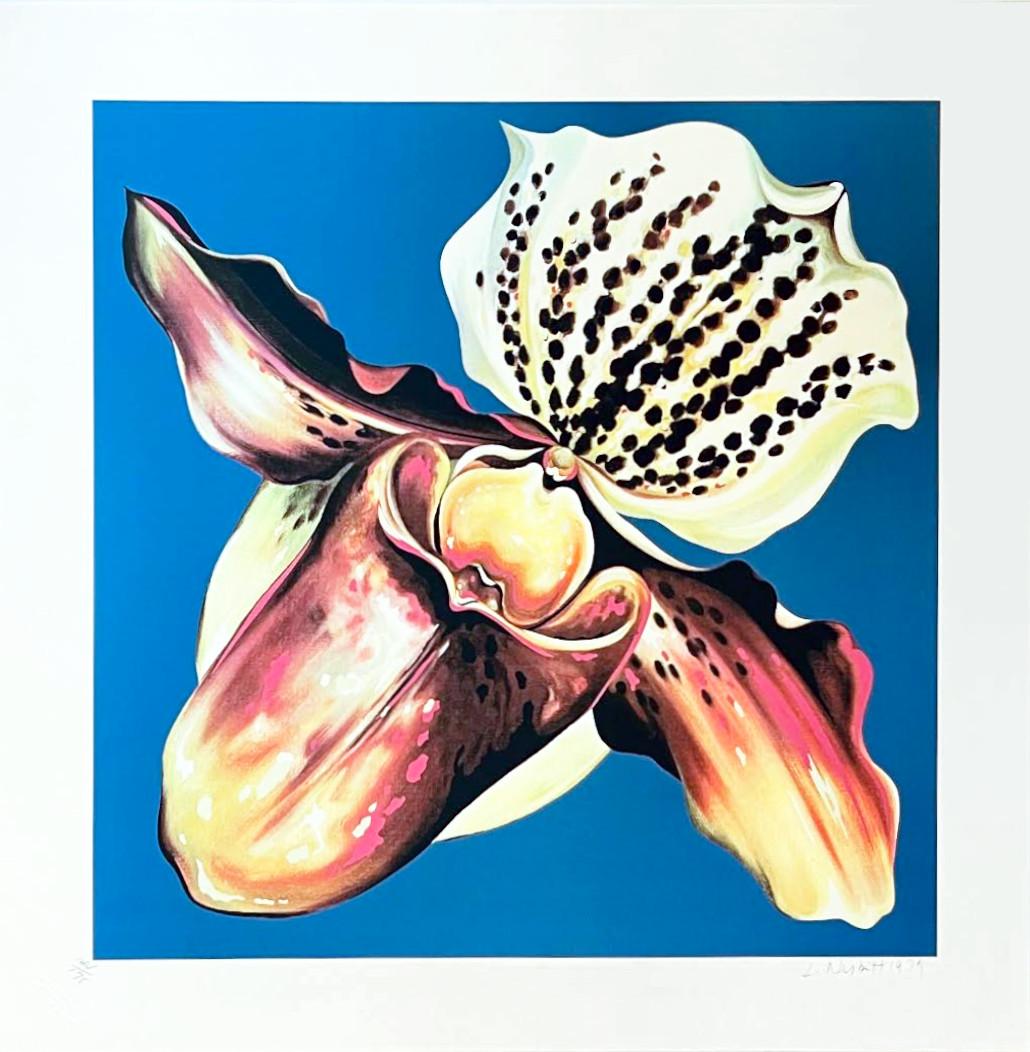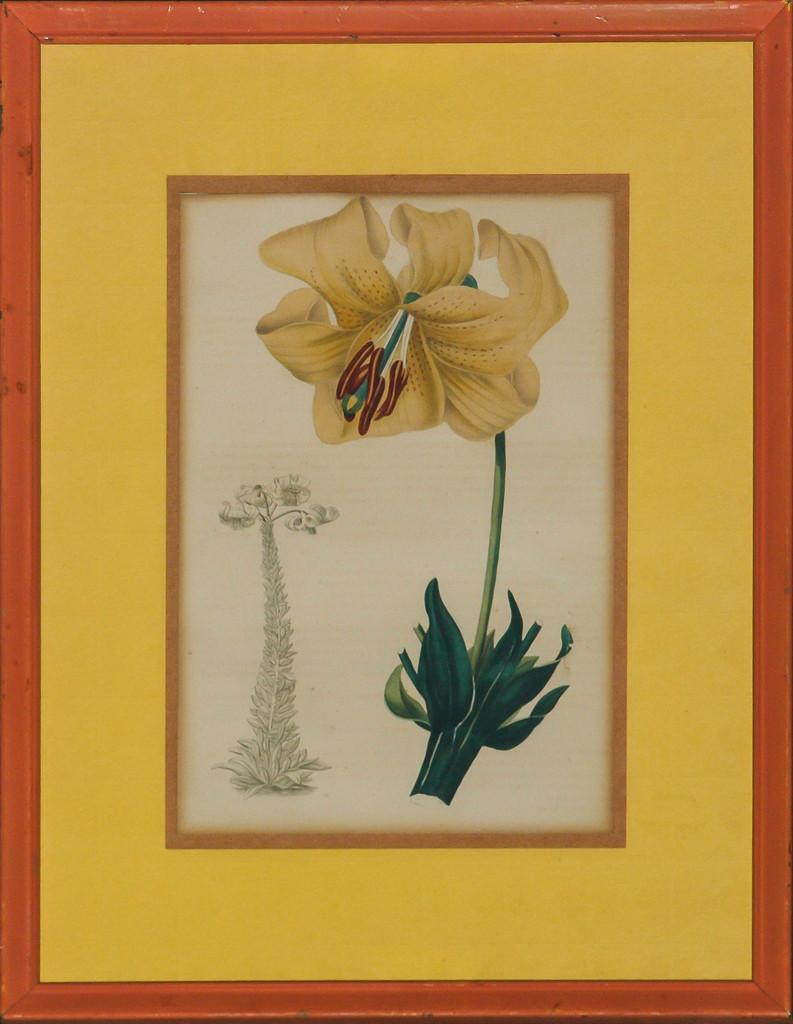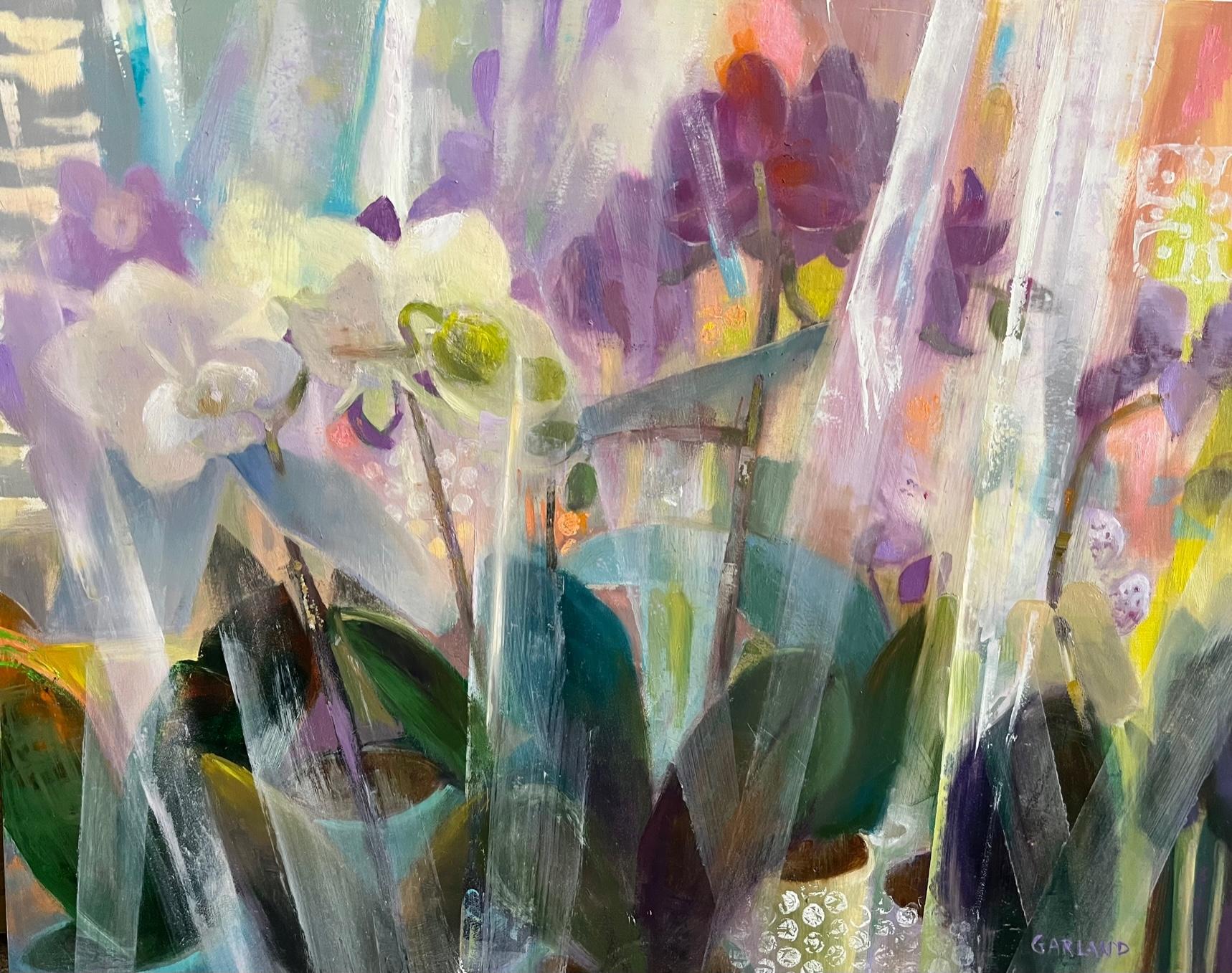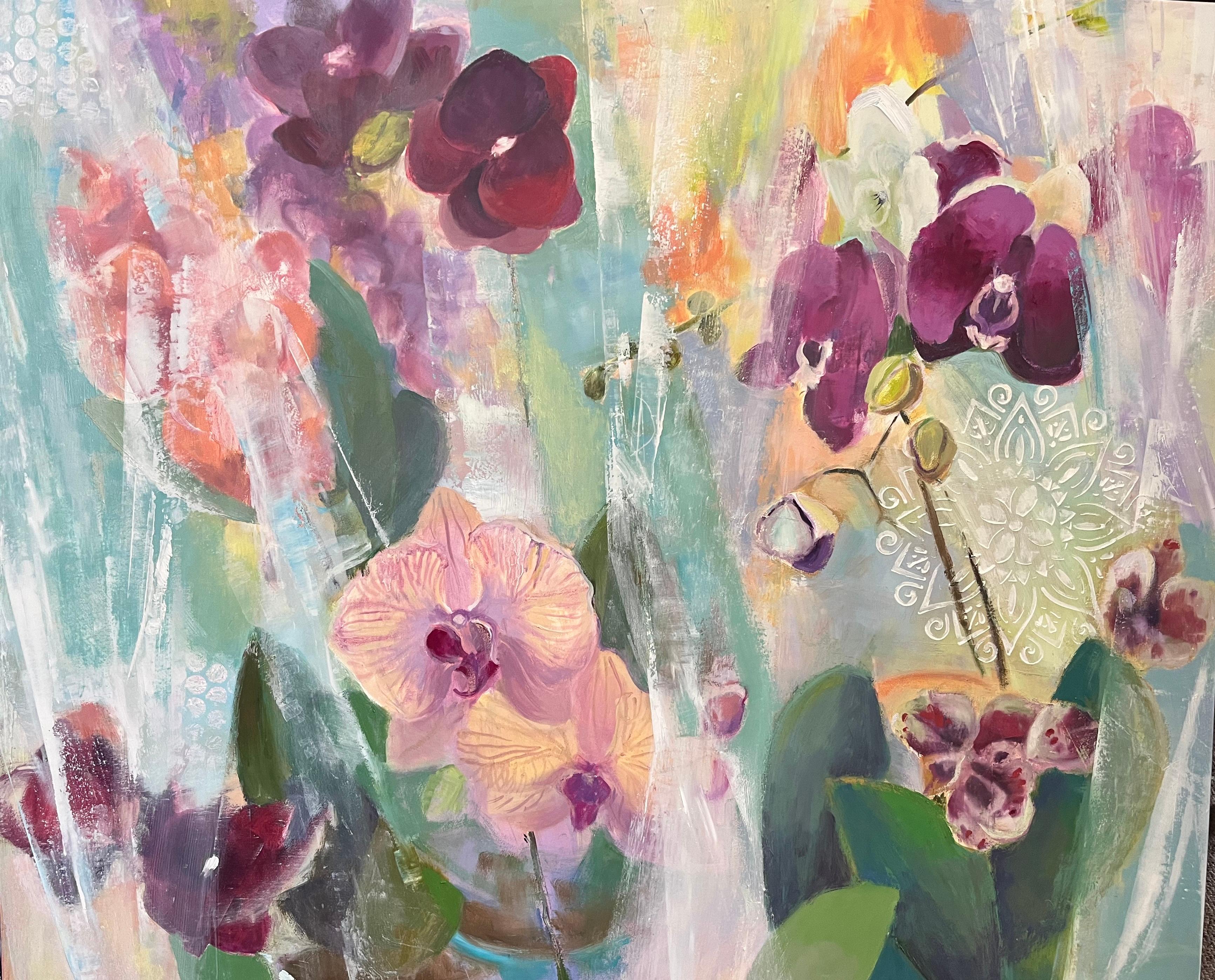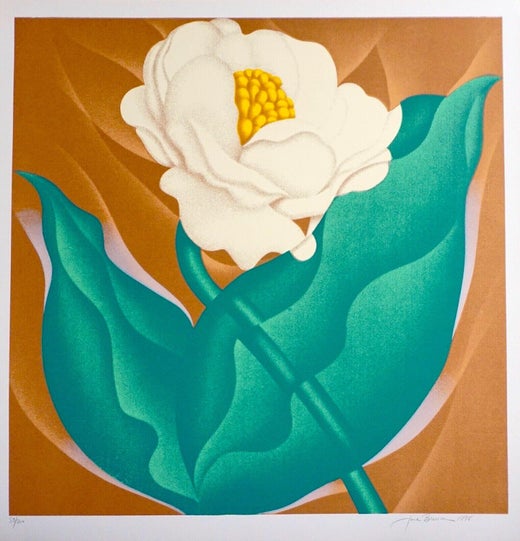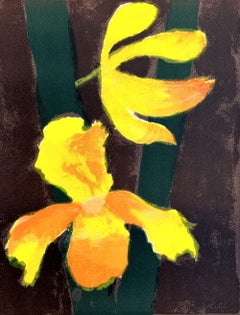Want more images or videos?
Request additional images or videos from the seller
1 of 9
Jack BruscaOrchid1979
1979
$725
£547.86
€632.64
CA$1,013.08
A$1,124.10
CHF 588.83
MX$13,784.43
NOK 7,489.66
SEK 7,069.92
DKK 4,718.01
Shipping
Retrieving quote...The 1stDibs Promise:
Authenticity Guarantee,
Money-Back Guarantee,
24-Hour Cancellation
About the Item
This artwork titled 'Orchid" 1979 is an original color silkscreen on paper by American artist Jack Brusca, 1939-1993. it is hand signed, dated and numbered 6/200 in pencil by the artist. The image size is 23.65 x 23.65 inches, framed size is 38.5 x 37.5 inches. It is custom framed in a wooden gold frame, with fabric matting and gold color bevel. it is in excellent condition.
About the artist:
Born in New York in 1939, Brusca studied at the University of New Hampshire and The School of Visual Arts, New York. His first one-man show was held at Galeria Bonino in New York in 1969. Since then his works have been displayed throughout the United States and South America. He has participated in numerous exhibitions including Expo '67, Montreal; Paintings and Sculptures Today, Indianapolis Museum of Art and Highlights of the Season at the Larry Aldrich Museum in Ridgefield, Conn.
He won critical praise when he had his first one-man show, in 1969 at the Bonino Galleria on West 57th Street, for painting that came out of Leger and the mechanistic tradition but was not enslaved to those origins.
At a 1973 show in that gallery, he was lauded by one critic as being "just about as sharp as they come" in the illusionistic representation of sleek three-dimensional forms through a mixture of surrealism, pop and hard-edged neo-realism.
His last one-man show, in 1989, was at the Paraty Gallery in SoHo. His paintings were also shown at several museums and acquired by the Whitney Museum and others.
He also designed sets and costumes for ballet. His costumes for Louis Falco's ballet "Escarpot," performed by Alvin Ailey Dance Theater at City Center in 1991, won critical praise. He also designed jewelry.
Jack Brusca died in 1993.
- Creator:Jack Brusca (1939, American)
- Creation Year:1979
- Dimensions:Height: 38.5 in (97.79 cm)Width: 37.5 in (95.25 cm)Depth: 1.25 in (3.18 cm)
- Medium:
- Movement & Style:
- Period:
- Condition:
- Gallery Location:San Francisco, CA
- Reference Number:Seller: bru/orc/011stDibs: LU66637205812
Jack Brusca
Jack Brusca (1939-1993) Jack Brusca an American artist, had his first one-man show at Galeria Bonino in New York in 1969. His ability to interpret ordinary things such as letters, numbers, and flowers, using spacial dimension and color blend give his work a theatrical-type light. He creates three-dimensional forms through a mixture of surrealism, pop, and hard-edged neo-realism. Bruscas works have been displayed throughout the United States and South America: Expo ’67 Montreal Indianapolis Museum of Art Larry Aldrich Museum – Ridgefield, CT He also designed sets and costumes for ballet. Most notably for Louis Falco’s ballet “Escarpot,” by Alvin Ailey Dance Theater in 1991.
About the Seller
5.0
Platinum Seller
Premium sellers with a 4.7+ rating and 24-hour response times
Established in 1999
1stDibs seller since 2017
808 sales on 1stDibs
Typical response time: 1 hour
- ShippingRetrieving quote...Shipping from: San Francisco, CA
- Return Policy
Authenticity Guarantee
In the unlikely event there’s an issue with an item’s authenticity, contact us within 1 year for a full refund. DetailsMoney-Back Guarantee
If your item is not as described, is damaged in transit, or does not arrive, contact us within 7 days for a full refund. Details24-Hour Cancellation
You have a 24-hour grace period in which to reconsider your purchase, with no questions asked.Vetted Professional Sellers
Our world-class sellers must adhere to strict standards for service and quality, maintaining the integrity of our listings.Price-Match Guarantee
If you find that a seller listed the same item for a lower price elsewhere, we’ll match it.Trusted Global Delivery
Our best-in-class carrier network provides specialized shipping options worldwide, including custom delivery.More From This Seller
View AllLily
By Lowell Nesbitt
Located in San Francisco, CA
This artwork "Lily" C.1975 is an original colors serigraph by noted American artist Lowell Nesbitt, 1933-1993. It is hand signed, dated and numbered A.P. 6/30 in pencil by the artist. The image size is 23.75 x 26 inches, sheet size is 29.35 x 31.25 inches. It is in excellent condition, it has a very light printing ink soiling at the left margin, see picture #6 and a light crease at the lower center margin.
About the artist:
Lowell Nesbitt, who was born in Baltimore on Oct. 4, 1933, was a graduate of the Tyler School of Art at Temple University in Philadelphia and also attended the Royal College of Art in London, where he worked in stained glass & etching.
In 1964, the Corcoran Gallery or Art in Washington gave him one of his first museum exhibitions, and by the mid 1970's he had decided to leave the museum a bequest of more than $1 million. But in 1989, he publicly revoked the bequest after the Corcoran canceled a disputed exhibition of photographs by Robert Mapplethorpe, who was an old friend. Mr. Nesbitt named the Phillips Collection as a beneficiary instead.
He was frequently grouped with the Photo Realists, but his images were more interpretively distorted, somewhat loosely painted and boldly abbreviated. He had many subjects: studio interiors, articles of clothing, piles of shoes and groupings of fruits and vegetables. He also painted his dog, a Rottweiler named Echo, the Neoclassical facades of SoHo's 19th century cast-iron buildings and several of Manhattan's major bridges.
Despite such variety, Lowell Nesbitt was best known for gargantuan images or irises, roses, lilies and other flowers, which he often depicted in close up so that their petals seemed to fill the canvas. Dramatic, implicitly sexual and a little ominous, they earned the artist a popularity with the general public that tended to overshadow his reputation within the art world.
In 1980, the United States Postal Service issued four stamps based on Mr. Nesbitt's floral paintings. He also served as the official artist for the space flights of Apollo 9 and Apollo 13.
SELECTED CORPORATE COLLECTIONS
-Amerada Hess Corporation, New York, New York
-AT&T, New York, New York
-Atlantic Richfield, Los Angeles, California
-Bank of New York, New York, New York
-Biblioteque Nationale, Paris, France
-Celenese Corporation, New York, New York
-Chase Manhattan Bank, New York, New York
-Citicorp, New York, New York
-Florists Trans World Delivery Collection of Contemporary Art, Detroit, Michigan
-Ford Motor Company, Dearborn, Michigan
-General Mills, Minneapolis, Minnesota
-Hess Shoe Corporation, Baltimore, Maryland
-Lehman Brothers Kuhn Loeb, Chicago, Illinois, New York, New York
-Maryland National Bank, Baltimore
-Mutual of Omaha, Washington D.C.
-Neiman-Marcus, Atlanta, Georgia
-Northern Trust Company, Chicago, Illinois
-J.C. Penny Corporation, New York, New York
-Prudential Insurance Company, Newark, New Jersey
-Schroeder Bank and Trust Company, New York, New York
SELECTED MUSEUM AND GOVERNMENT COLLECTIONS.
-American Embassies: Monrovia, Dar es Salaam, Tel Aviv, Sao Paulo
-The Art Institute of Chicago, Illinois
-Baltimore Museum of Art, Maryland
-Castel Gandolfo, Rome, Collection of Pope Paul II
-Corcoran Gallery of Art, Washington D.C.
-Dallas Museum of Fine Arts, Dallas, Texas
-Detroit Institute of Art, Detroit, Michigan
-Edwin A. Ulrich Museum of Art, Wichita State University, Kansas
-Enviromental Protection Agency, Washington D.C.
-Federal Reserve Bank, Baltimore, Maryland
-Fogg Art Museum, Cambridge, Mass.
-Fort Worth Art Center, Texas
-The High Museum of Art, Atlanta, Georgia
-Hirshhorn Museum and Sculpture Garden, Washington D.C.
-International Monetary Fund, Washington D.C.
-Israel Museum, Jerusalem
-John and Mable Ringling Museum of Art, Sarasota, Florida
-Library of Congress, Washington D.C.
-Loch Haven Art Center, Florida
-Massachusetts Institute of Technology, Boston
SELECTED SOLO EXHIBITIONS
1958:
Baltimore Museum of Art, Baltimore, MD
1971:
-Gimpel Fils, London, England
-Gimpel and Weitzenhoffer, New York, NY
1972:
-Kunstverein, Frieburg, Germany
-Galerie Arneson, Copenhagen, Denmark
-Gerlerie Aronovitsch, Stockholm, Sweden
1973:
The Corcoran Gallery of Art, Washington D.C.
1974:
Gimpel Fils, London, England
1975:
The Corcoran Gallery of Art, Washington D.C.
1976:
Hayden, Massachusetts Institute of Technology, Cambridge, MA
1977:
Edwin A. Ulrich Museum of Art, Wichita KS
1978:
Kent State University, Kent, OH
1979:
Selby Botanical Gardens, Museum of Botany and the Art's, Sarasota, FL
1980:
Marion Koogler Mcnay Art Institute, San Antonio, TX
1981:
Editions Inc, Houston TX
1982:
Butler Institute of American Art, Youngstown, OH
1983:
Atlantic Center for the Art, New Smyrna Beach, FL
1984:
Oklahoma Art Center, Oklahoma City, OK
1989:
Tyler Gallery...
Category
Late 20th Century American Realist Figurative Prints
Materials
Screen
Iris
By Gary Bukovnik
Located in San Francisco, CA
This artwork titled "Iris" 1998 is an original color lithograph on Wove paper by noted American artist Gary Bukovnik, born 1947. It is hand signed, dated and numbered 109/200 in pencil by the artist. The image size is 10 x 9.75 inches, sheet size is 14.75 x 13.5 inches. It is in excellent condition, the colors are fresh and bright, has never been framed.
About the artist.
Born and educated in Cleveland Gary Bukovnik has lived in San Francisco for over 25 years. Primarily using the mediums of watercolor, monotype, and lithograph, Bukovnik creating colorful floral images of great depth and intensity.
Bukovnik collaborates with Trillium Press, whose owner and master printer, David Salgado, studied at the Tamarind Workshop, formerly in Los Angeles.
In 2003, the American Academy in Rome invited Bukovnik to attend the academy as a Visiting Artist for six weeks. He was asked to attend a second session in February 2005. In 2001, he was selected to create a poster for the prestigious List Collection, which creates posters to commemorate programs at Lincoln Center for the Performing Arts in New York. Lincoln Center past contributors have included Roy Lichtenstein, Andy Warhol, Robert Motherwell, Helen Frankenthaler, Alex Katz, Elizabeth Murray, and Donald Sultan. The work of Gary Bukovnik is held in public and private collections worldwide.
Selected Museums
Art Gallery of Hamilton, Ontario The Art Institute of Chicago Atlanta Botanical Garden Brooklyn Museum
Brooks Museum of Art, Memphis
The Butler Institute of American Art, Youngstown Dallas Museum of Art
Fine Arts Museums of San Francisco
Frye Art Museum, Seattle
Hunt Institute for Botanical Documentation, Carnegie Mellon University, Pittsburgh
Hunterian Art Gallery, University of Glasgow
Library of Congress, Washington, DC
The Metropolitan Museum of Art, New York
The Minneapolis Institute of Arts, Minnesota Museum of Fine Arts, Boston
The Museum of Modern Art, New York
The Richard L. Nelson Gallery, U.C. Davis, California The New York Public Library
Oakland Museum of California
Philadelphia Museum of Art
Phoenix Art Museum
Portland Art Museum, Oregon
Rhode Island School of Design Museum, Providence San Francisco Museum of Modern Art
University of Arizona Museum of Art, Tucson University of California, Berkeley Art Museum
Selected public collections
ALZA Corporation, Mountain View
ART In Embassies Program, U.S. Department of State
AT&T, New York
Atlantic Richfield, Los Angeles
BankAmerica Corporation, Charlotte
Citigroup, New York
Cleveland Institute of Music
Clorox Company, Oakland
Comerica Bank, Costa Mesa & San Jose
H.J. Heinz Company, Pittsburgh
Illinois Bell Telephone...
Category
Mid-20th Century American Realist Still-life Prints
Materials
Lithograph
Untitled (Abstract Flower)
By Kate Delos
Located in San Francisco, CA
Artist: Kate Delos – Mexican/American (1945- )
Title: Untitled – Abstract Flower
Year: 1983
Medium: Monotype
Image size: 15.5 x 11.75 inches.
Paper si...
Category
1980s Abstract Expressionist Abstract Prints
Materials
Paper, Monotype
Expanding
By Betty Rees Heredia
Located in San Francisco, CA
This artwork titled "Expandingr" 2001 is a original color lithograph on wove paper by American artist Betty Rees Heredia A.K.A Betty Snyder Shapiro,...
Category
Late 20th Century American Modern Abstract Prints
Materials
Lithograph
Flourish
By Richard Royce
Located in San Francisco, CA
This artwork titled "Flourish" is a cast paper bas relief by noted American artist Richard Benjamin Royce, born 1941. It is signed at the lower right ...
Category
Late 20th Century American Modern Mixed Media
Materials
Paper
Cascade
By Bruce Weinberg
Located in San Francisco, CA
This artwork titled "Cascade" 1991 is a color etching, with embossing and gold addition on handmade paper by noted artist Bruce Weinberg, 1942-1994 It is hand signed, titled, numbere...
Category
Late 20th Century American Modern Abstract Prints
Materials
Mixed Media
You May Also Like
Orchids - Original lithograph handsigned - 100 copies
By Bernard Cathelin
Located in Paris, IDF
Bernard CATHELIN
Orchids
Original lithograph, 1988
Handsigned in pencil
Inscribed EA (épreuve d'artiste) aside the edition of 100 copies
On Arches paper, size 40 x 31 (c. 15 8/10 x ...
Category
1980s Modern Still-life Prints
Materials
Lithograph
Orchid, gorgeous signed/n silkscreen by renowned 1970s realist artist
By Lowell Nesbitt
Located in New York, NY
Lowell Nesbitt
Orchid, 1979
Silkscreen on wove paper
Pencil signed, dated and numbered 144/175 by Lowell Nesbitt on the front
Published by Charles Cardinale Fine Creations, Inc., with blind stamp on the front
25 × 25 inches
Unframed
This work is pencil signed, dated and numbered 144/175 by Lowell Nesbitt on the front.
About Lowell Nesbitt.
Lowell Nesbitt, who was born in Baltimore on Oct. 4, 1933, was a graduate of the Tyler School of Art at Temple University in Philadelphia and also attended the Royal College of Art in London, where he worked in stained glass & etching. In 1964, the Corcoran Gallery or Art in Washington gave him one of his first museum exhibitions, and by the mid 1970's he had decided to leave the museum a bequest of more than $1 million. But in 1989, he publicly revoked the bequest after the Corcoran canceled a disputed exhibition of photographs by Robert Mapplethorpe, who was an old friend. Mr. Nesbitt named the Phillips Collection as a beneficiary instead. He was frequently grouped with the Photo Realists, but his images were more interpretively distorted, somewhat loosely painted and boldly abbreviated. He had many subjects: studio interiors, articles of clothing, piles of shoes and groupings of fruits and vegetables. He also painted his dog, a Rottweiler named Echo, the Neoclassical facades of SoHo's 19th century cast-iron buildings and several of Manhattan's major bridges. Despite such variety, Lowell Nesbitt was best known for gargantuan images or irises, roses, lilies and other flowers, which he often depicted in close up so that their petals seemed to fill the canvas. Dramatic, implicitly sexual and a little ominous, they earned the artist a popularity with the general public that tended to overshadow his reputation within the art world. In 1980, the United States Postal Service issued four stamps based on Mr. Nesbitt's floral paintings. He also served as the official artist for the space flights of Apollo 9...
Category
1970s Realist Figurative Prints
Materials
Screen, Pencil, Graphite
$1,000 Sale Price
33% Off
"Orchid"
Located in Bristol, CT
Charming decoupage hand-coloured print of botanical orchid flower
Print Sz: 8 1/2"H x 5 1/2"W
Frame Sz: 12 1/2"H x 9 3/4"W
Category
20th Century Drawings and Watercolor Paintings
Materials
Lithograph
$250
Bamboo Orchids
By Katherine Kean
Located in Palm Desert, CA
A wild orchid flower’s delicate form is highlighted by the sun. Vivid pinks stand out before a deep forest green background. Oil on a one quarter inch linen panel. Signed by the artist. Includes a simple wood plein air frame...
Category
21st Century and Contemporary Contemporary Still-life Paintings
Materials
Linen, Oil
$480 Sale Price
20% Off
Orchids for Sale
By Carole Garland
Located in Palm Desert, CA
Everyday life is full of surprises, and artist Carole Garland uncovers and discovers delight in the cellophane wrapped orchids at Trader Joe’s. The cellophane reflects the sunlight ...
Category
21st Century and Contemporary Contemporary Still-life Paintings
Materials
Oil, Wood Panel
$2,000 Sale Price
20% Off
Orchids on Parade
By Carole Garland
Located in Palm Desert, CA
Descriptive text: Cellophane wrapped orchids caught the eye of artist Carole Garland, and she chose to paint the peekaboo flowers in this abstracted oil painting. This is a new subje...
Category
21st Century and Contemporary Contemporary Interior Paintings
Materials
Oil, Wood Panel
$1,600 Sale Price
20% Off

